Efficacy and safety of inhaled carbon monoxide during pulmonary inflammation in mice
- PMID: 20644637
- PMCID: PMC2903490
- DOI: 10.1371/journal.pone.0011565
Efficacy and safety of inhaled carbon monoxide during pulmonary inflammation in mice
Abstract
Background: Pulmonary inflammation is a major contributor to morbidity in a variety of respiratory disorders, but treatment options are limited. Here we investigate the efficacy, safety and mechanism of action of low dose inhaled carbon monoxide (CO) using a mouse model of lipopolysaccharide (LPS)-induced pulmonary inflammation.
Methodology: Mice were exposed to 0-500 ppm inhaled CO for periods of up to 24 hours prior to and following intratracheal instillation of 10 ng LPS. Animals were sacrificed and assessed for intraalveolar neutrophil influx and cytokine levels, flow cytometric determination of neutrophil number and activation in blood, lung and lavage fluid samples, or neutrophil mobilisation from bone marrow.
Principal findings: When administered for 24 hours both before and after LPS, inhaled CO of 100 ppm or more reduced intraalveolar neutrophil infiltration by 40-50%, although doses above 100 ppm were associated with either high carboxyhemoglobin, weight loss or reduced physical activity. This anti-inflammatory effect of CO did not require pre-exposure before induction of injury. 100 ppm CO exposure attenuated neutrophil sequestration within the pulmonary vasculature as well as LPS-induced neutrophilia at 6 hours after LPS, likely due to abrogation of neutrophil mobilisation from bone marrow. In contrast to such apparently beneficial effects, 100 ppm inhaled CO induced an increase in pulmonary barrier permeability as determined by lavage fluid protein content and translocation of labelled albumin from blood to the alveolar space.
Conclusions: Overall, these data confirm some protective role for inhaled CO during pulmonary inflammation, although this required a dose that produced carboxyhemoglobin values close to potentially toxic levels for humans, and increased lung permeability.
Conflict of interest statement
Figures

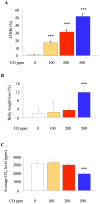
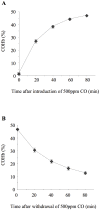



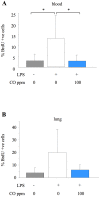
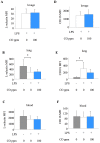
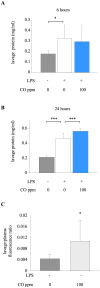
Similar articles
-
Evaluation of inhaled carbon monoxide as an anti-inflammatory therapy in a nonhuman primate model of lung inflammation.Am J Physiol Lung Cell Mol Physiol. 2010 Dec;299(6):L891-7. doi: 10.1152/ajplung.00366.2009. Epub 2010 Aug 20. Am J Physiol Lung Cell Mol Physiol. 2010. PMID: 20729385
-
Effects of inhaled carbon monoxide on acute lung injury in mice.Am J Physiol Lung Cell Mol Physiol. 2005 Jun;288(6):L1003-9. doi: 10.1152/ajplung.00451.2004. Epub 2005 Jan 28. Am J Physiol Lung Cell Mol Physiol. 2005. PMID: 15681391
-
Nebulized Heparin Attenuates Pulmonary Coagulopathy and Inflammation through Alveolar Macrophages in a Rat Model of Acute Lung Injury.Thromb Haemost. 2017 Nov;117(11):2125-2134. doi: 10.1160/TH17-05-0347. Epub 2017 Nov 30. Thromb Haemost. 2017. PMID: 29202212 Free PMC article.
-
Protection of carbon monoxide intraperitoneal administration from rat intestine injury induced by lipopolysaccharide.Chin Med J (Engl). 2010 Apr 20;123(8):1039-46. Chin Med J (Engl). 2010. PMID: 20497711
-
Inhibitory effects of flavonoids extracted from licorice on lipopolysaccharide-induced acute pulmonary inflammation in mice.Int Immunopharmacol. 2009 Feb;9(2):194-200. doi: 10.1016/j.intimp.2008.11.004. Epub 2008 Dec 9. Int Immunopharmacol. 2009. PMID: 19071231
Cited by
-
Differential exposure and acute health impacts of inhaled solid-fuel emissions from rudimentary and advanced cookstoves in female CD-1 mice.Environ Res. 2018 Feb;161:35-48. doi: 10.1016/j.envres.2017.10.043. Epub 2017 Nov 1. Environ Res. 2018. PMID: 29100208 Free PMC article.
-
The composition of cigarette smoke determines inflammatory cell recruitment to the lung in COPD mouse models.Clin Sci (Lond). 2014 Feb;126(3):207-21. doi: 10.1042/CS20130117. Clin Sci (Lond). 2014. PMID: 23875733 Free PMC article.
-
Impaired wound healing predisposes obese mice to severe influenza virus infection.J Infect Dis. 2012 Jan 15;205(2):252-61. doi: 10.1093/infdis/jir729. Epub 2011 Dec 5. J Infect Dis. 2012. PMID: 22147799 Free PMC article.
-
Exposure to Cigarette Smoke Augments Post-ischemic Brain Injury and Inflammation via Mobilization of Neutrophils and Monocytes.Front Immunol. 2019 Nov 7;10:2576. doi: 10.3389/fimmu.2019.02576. eCollection 2019. Front Immunol. 2019. PMID: 31787973 Free PMC article.
-
The role of fuel type and combustion phase on the toxicity of biomass smoke following inhalation exposure in mice.Arch Toxicol. 2019 Jun;93(6):1501-1513. doi: 10.1007/s00204-019-02450-5. Epub 2019 Apr 20. Arch Toxicol. 2019. PMID: 31006059 Free PMC article.
References
-
- Ryter SW, Alam J, Choi AM. Heme oxygenase-1/carbon monoxide: from basic science to therapeutic applications. Physiol Rev. 2006;86:583–650. - PubMed
-
- Chapman JT, Otterbein LE, Elias JA, Choi AM. Carbon monoxide attenuates aeroallergen-induced inflammation in mice. Am J Physiol Lung Cell Mol Physiol. 2001;281:L209–216. - PubMed
-
- Dolinay T, Szilasi M, Liu M, Choi AM. Inhaled carbon monoxide confers antiinflammatory effects against ventilator-induced lung injury. Am J Respir Crit Care Med. 2004;170:613–620. - PubMed
-
- Kohmoto J, Nakao A, Stolz DB, Kaizu T, Tsung A, et al. Carbon monoxide protects rat lung transplants from ischemia-reperfusion injury via a mechanism involving p38 MAPK pathway. Am J Transplant. 2007;7:2279–2290. - PubMed

